Related Research Articles
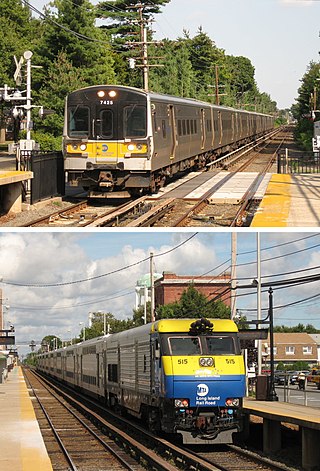
The Long Island Rail Road, often abbreviated as the LIRR, is a commuter rail system in the southeastern part of the U.S. state of New York, stretching from Manhattan to the eastern tip of Suffolk County on Long Island. With an average weekday ridership of 354,800 passengers in 2016, it is the busiest commuter railroad in North America. It is also one of the world's few commuter systems that runs 24/7 year-round. It is publicly owned by the Metropolitan Transportation Authority, which refers to it as MTA Long Island Rail Road. In 2022, the system had a ridership of 70,342,700, or about 253,800 per weekday as of the second quarter of 2023.

Jamaica is a major train station of the Long Island Rail Road located in Jamaica, Queens, New York City. With weekday ridership exceeding 200,000 passengers, it is the largest transit hub on Long Island, the fourth-busiest rail station in North America, and the second-busiest station that exclusively serves commuter traffic. It is the third-busiest rail hub in the New York area, behind Penn Station and Grand Central Terminal. Over 1,000 trains pass through each day, the fourth-most in the New York area behind Penn Station, Grand Central Terminal, and Secaucus Junction.
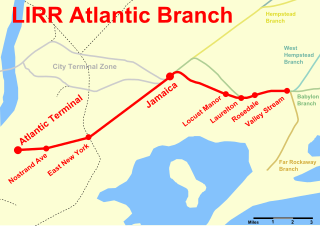
The Atlantic Branch is an electrified rail line owned and operated by the Long Island Rail Road in the U.S. state of New York. It is the only LIRR line with revenue passenger service in the borough of Brooklyn.

Locust Manor is a station on the Long Island Rail Road's Atlantic Branch in the Locust Manor neighborhood of Queens, New York City. The station is located at Farmers Boulevard and Bedell Street and is 14.0 miles (22.5 km) from Penn Station in Midtown Manhattan. The stop serves the Rochdale, Queens section and its Rochdale Village apartment complex, and was also the stop for the racecourse on which Rochdale Village was erected, Jamaica Race Course. Today it contains fiberglass populuxe designed shelters on high-level platforms.

The Jamaica–Van Wyck station is a station on the IND Archer Avenue Line of the New York City Subway, located on the west side of the Van Wyck Expressway between Metropolitan Avenue and 89th Avenue on the border of Kew Gardens and Richmond Hill, Queens. It is served by the E train at all times.

The Laurelton station is a station on the Long Island Rail Road's Atlantic Branch, in the Laurelton neighborhood of Queens, New York City. It is 14.9 miles (24.0 km) from Penn Station in Midtown Manhattan. The station is located at the intersection of 225th Street and 141st Road.

The Far Rockaway Branch is an electrified rail line and service owned and operated by the Long Island Rail Road in the U.S. state of New York. The branch begins at Valley Interlocking, just east of Valley Stream station. From Valley Stream, the line heads south and southwest through southwestern Nassau County, ending at Far Rockaway in Queens, thus reentering New York City. LIRR maps and schedules indicate that the Far Rockaway Branch service continues west along the Atlantic Branch to Jamaica. This two-track branch provides all day service in both directions to Grand Central Madison and Penn Station, both in Midtown Manhattan

The Montauk Branch is a rail line owned and operated by the Long Island Rail Road in the U.S. state of New York. The line runs the length of Long Island, 115 miles (185 km) from Long Island City to Montauk. However, in LIRR maps and schedules for public use, the term Montauk Branch refers to the line east of Babylon; service from Jamaica to Babylon is covered by separate Babylon Branch schedules, while the line west of Jamaica is currently unused for passenger service. A select number of Montauk Branch trains operate via the Main Line during peak hours.
The North Shore Bus Company operated public buses in Queens, New York City. It was established in 1920 as the successor to the New York and North Shore Traction Company trolley system, and operated until 1947 when it went bankrupt, and its operations were taken over by the New York City Board of Transportation.
The Long Island Rail Road is a railroad owned by the Metropolitan Transportation Authority in the U.S. state of New York. It is the oldest United States railroad still operating under its original name and charter. It consolidated several other companies in the late 19th century. The Pennsylvania Railroad owned the Long Island Rail Road for the majority of the 20th century and sold it to the State in 1966.

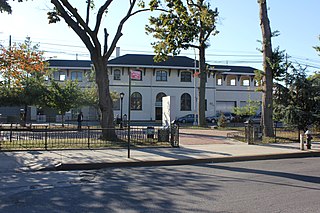
Queens Village is a station on the Long Island Rail Road's Main Line, located between 218th Street and Springfield Boulevard, in the Queens Village neighborhood of Queens, New York City. It has two side platforms along the four-track line, and is served by Hempstead Branch trains. Just east of the station is Queens Interlocking, a universal interlocking that splits the four-track line into two parallel two-track lines—the Main Line and Hempstead Branch—and controls the junction with the spur to Belmont Park. The station is elevated and the tracks leading in and out are on raised ground and only above the road at intersections.
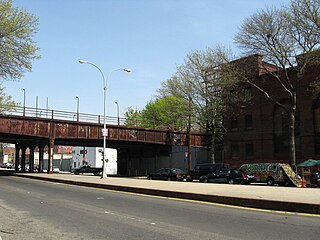
Woodhaven Junction was a station complex on the Atlantic Branch and Rockaway Beach Branch of the Long Island Rail Road, located at Atlantic Avenue between 98th and 100th Streets in Woodhaven, Queens, New York City. The elevated Rockaway Beach station was closed in 1962 along with the rest of the branch, while the underground Atlantic Branch station was closed and abandoned on January 7, 1977.
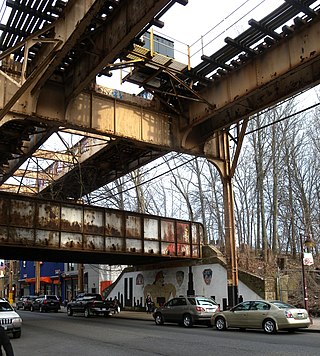
Brooklyn Manor was a station on the Long Island Rail Road's Rockaway Beach Branch located on the south side of Jamaica Avenue at 100th Street, straddling the border between Richmond Hill and Woodhaven in Queens, New York City. The station name referred to the nearby Brooklyn Manor section of Woodhaven, originally a 603-lot development bounded by Woodhaven Boulevard to the west, 96th/98th Streets to the east, Forest Park to the north, and Jamaica Avenue to the south. The station opened in January 1911, and was constructed as a replacement for the Brooklyn Hills station, which was located 3,000 feet (910 m) to the north. This station closed along with the rest of the Rockaway Beach Branch in 1962, and was subsequently demolished.

The Richmond Hill station is a closed station on the Montauk Branch of the Long Island Rail Road in the Richmond Hill neighborhood of Queens in New York City. The station is located at Myrtle Avenue and cuts diagonally from the intersection of Jamaica Avenue and Lefferts Boulevard through to Hillside Avenue. The station has two tracks and an island platform. Richmond Hill was the only station on the Lower Montauk Branch that was elevated with a high-level platform for passengers to wait for trains; the others were at ground level, with low-level platforms.
Central Railroad of Long Island was built on Long Island, New York, by Alexander Turney Stewart, who was also the founder of Garden City. The railroad was established in 1871, then merged with the Flushing and North Side Railroad in 1874 to form the Flushing, North Shore and Central Railroad. It was finally acquired by the Long Island Rail Road in 1876 and divided into separate branches. Despite its short existence, the CRRLI had a major impact on railroading and development on Long Island.
Springfield Gardens was an island platform station that existed along the Babylon-Montauk Branch of the Long Island Rail Road, in the Springfield Gardens, Queens section of Queens, New York City. The station was located between St. Albans and Rosedale Stations, north of Springfield Junction. The only visible evidence of the station today is a wide gap between the tracks.
Bellaire was a station stop along the Hempstead Branch of the Long Island Rail Road. The station was located between 211th Street and 212th Street between 99th Avenue and Jamaica Avenue in Bellaire, Queens.
Cedar Manor, originally named Power Place was a railroad station along the Atlantic Branch of the Long Island Rail Road, in Queens, New York City.
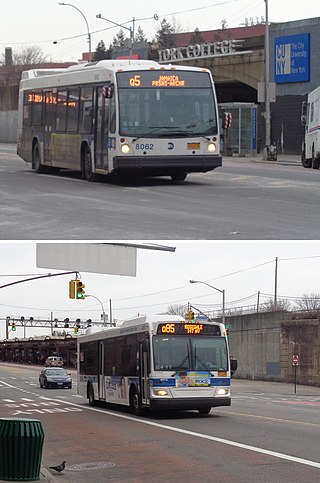
The Q5 and Q85 bus routes constitute a public transit corridor running along Merrick Boulevard in southeastern Queens, New York City. The routes run from the Jamaica Center transit hub and business district to Rosedale, with continued service to Green Acres Mall in Valley Stream, Nassau County. The Q4 and Q84 buses also serve the northern portion of the corridor, before diverging east along Linden Boulevard and 120th Avenue respectively. The Q4, Q5, and Q85 also provide limited-stop service along the corridor. The routes on the corridor mainly serve as feeder routes to New York City Subway services at Jamaica Center–Parsons/Archer station.
References
- ↑ LIRR Station History (TrainsAreFun.com) Archived 2011-01-06 at the Wayback Machine
- ↑ Long Island Railroad Mainline to Hicksville & Hempstead Branch Timetable 1915
- ↑ "State Can't Operate LIRR: Transit Board". Newsday. November 16, 1949. Retrieved March 31, 2023.
- ↑ "RR Denies Plea to Close 3 Depots". Newsday. November 23, 1949. Retrieved March 31, 2023.
- ↑ "Fight Closing of 2 LI Depots". New York Daily News. November 28, 1949. Retrieved March 31, 2023.
- 1 2 "PSC Gets LIRR Plea to Give Up 2 Stations". New York Daily New. February 3, 1955. Retrieved March 31, 2023.
- ↑ "LIRR's Plea to Close Two Stations Fought". New York Daily News. February 6, 1955. Retrieved March 31, 2023.
- ↑ "Resume LIRR Station Drop Hearing May 4". New York Daily News. March 27, 1955. Retrieved March 31, 2023.
- ↑ "L.I. to Shut Station, Must Keep Another". The New York Times. July 23, 1955. ISSN 0362-4331 . Retrieved March 31, 2023.
- ↑ "LIRR Permitted to Shut Station". New York Daily News. July 23, 1955. Retrieved March 31, 2023.
- ↑ "Ask OK to Remove Agent at LIRR Stop". Newsday. October 15, 1958. Retrieved March 19, 2023– via Newspapers.com.
- ↑ Old Southern Road from Jamaica Station to Springfield Junction (Arrt's Arrchives)
- ↑ "LIRR Sprouting Modern Branch". New York Daily News. January 27, 1960. pp. B5. Retrieved March 31, 2023.